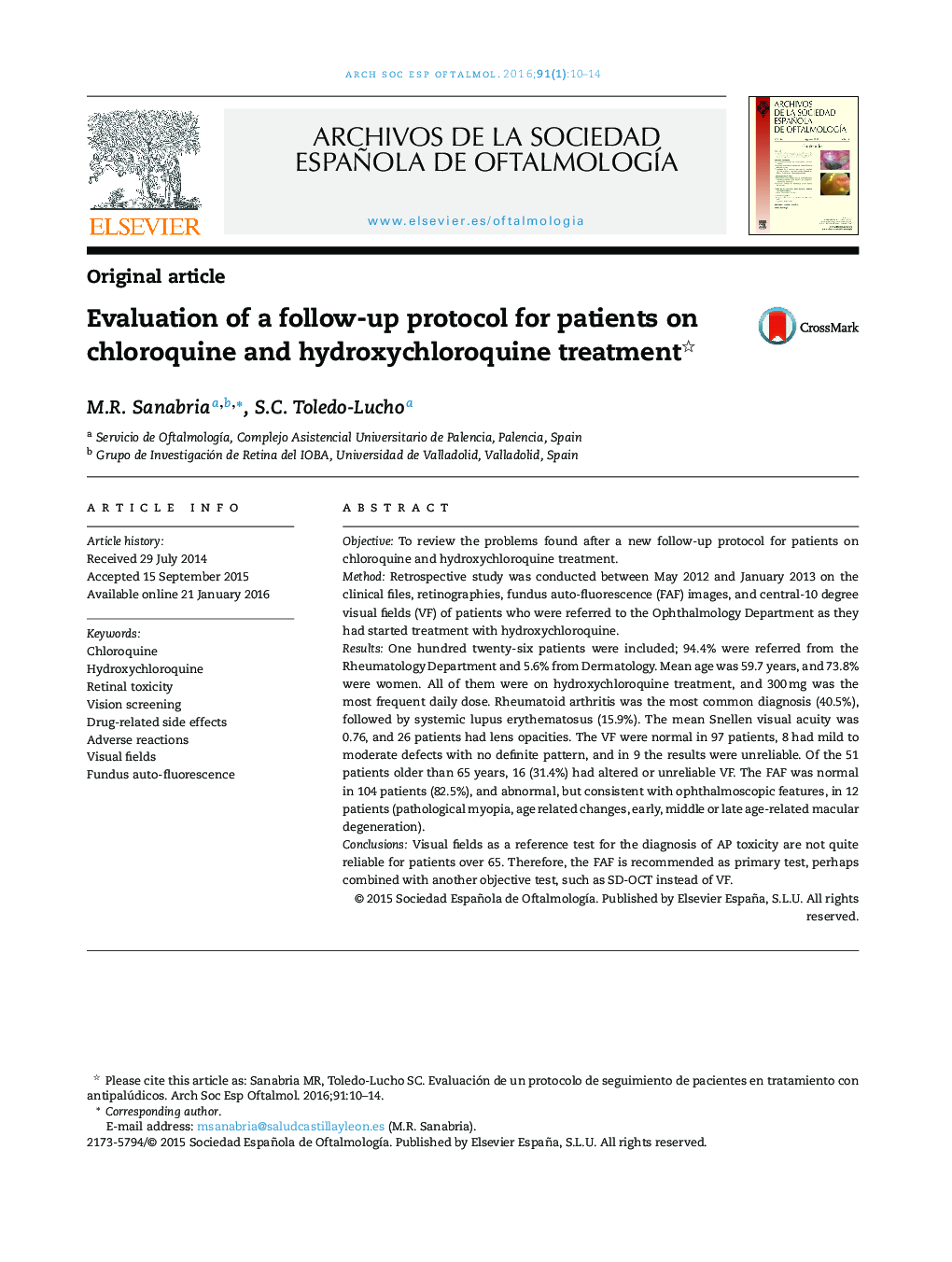| کد مقاله | کد نشریه | سال انتشار | مقاله انگلیسی | نسخه تمام متن |
|---|---|---|---|---|
| 4007973 | 1260839 | 2016 | 5 صفحه PDF | دانلود رایگان |
ObjectiveTo review the problems found after a new follow-up protocol for patients on chloroquine and hydroxychloroquine treatment.MethodRetrospective study was conducted between May 2012 and January 2013 on the clinical files, retinographies, fundus auto-fluorescence (FAF) images, and central-10 degree visual fields (VF) of patients who were referred to the Ophthalmology Department as they had started treatment with hydroxychloroquine.ResultsOne hundred twenty-six patients were included; 94.4% were referred from the Rheumatology Department and 5.6% from Dermatology. Mean age was 59.7 years, and 73.8% were women. All of them were on hydroxychloroquine treatment, and 300 mg was the most frequent daily dose. Rheumatoid arthritis was the most common diagnosis (40.5%), followed by systemic lupus erythematosus (15.9%). The mean Snellen visual acuity was 0.76, and 26 patients had lens opacities. The VF were normal in 97 patients, 8 had mild to moderate defects with no definite pattern, and in 9 the results were unreliable. Of the 51 patients older than 65 years, 16 (31.4%) had altered or unreliable VF. The FAF was normal in 104 patients (82.5%), and abnormal, but consistent with ophthalmoscopic features, in 12 patients (pathological myopia, age related changes, early, middle or late age-related macular degeneration).ConclusionsVisual fields as a reference test for the diagnosis of AP toxicity are not quite reliable for patients over 65. Therefore, the FAF is recommended as primary test, perhaps combined with another objective test, such as SD-OCT instead of VF.
ResumenObjetivoEvaluar el protocolo implantado en nuestro hospital para el cribado de toxicidad ocular por antipalúdicos (AP) revisando las características de los pacientes estudiados y los problemas encontrados tras su implantación.MétodoEstudio retrospectivo de las historias clínicas, retinografías, fotos de autofluorescencia (FAF) y campos visuales (CV) centrales 10-2 de los pacientes que iban a iniciar tratamiento con AP, desde el momento de la implantación del protocolo en mayo de 2012 hasta enero de 2014.ResultadosSe han revisado 126 pacientes. El 94,4% procedían del servicio de reumatología y el 5,6%, del de dermatología. La edad media fue de 59,7 años, y el 73,8% fueron mujeres. Todos estaban en tratamiento con hidroxicloroquina, siendo la dosis más frecuente 300 mg diarios. La artritis reumatoide fue el diagnóstico más frecuente (40,5%), seguido del lupus eritematoso (15,9%). La agudeza visual media fue de 0,76; 26 pacientes presentaban opacidades de cristalino. En 97 pacientes los CV resultaron normales, 8 presentaron defectos leves o moderados sin patrón definido, y en 9 los resultados fueron poco fiables. De los 51 pacientes mayores de 65 años, 16 (31,4%) presentaron CV alterados o no valorables. La FAF resultó normal en 104 pacientes (82,5%) y anormal, aunque congruente con los hallazgos oftalmoscópicos, en 12 pacientes.ConclusionesEl rendimiento de los CV como test de referencia para el diagnóstico de toxicidad por AP es relativamente bajo en pacientes mayores de 65 años. Por ello creemos recomendable usar la FAF como test primordial y asociarlo quizás a otro test objetivo, como el SD-OCT, en detrimento de los CV.
Journal: Archivos de la Sociedad Española de Oftalmología (English Edition) - Volume 91, Issue 1, January 2016, Pages 10–14
